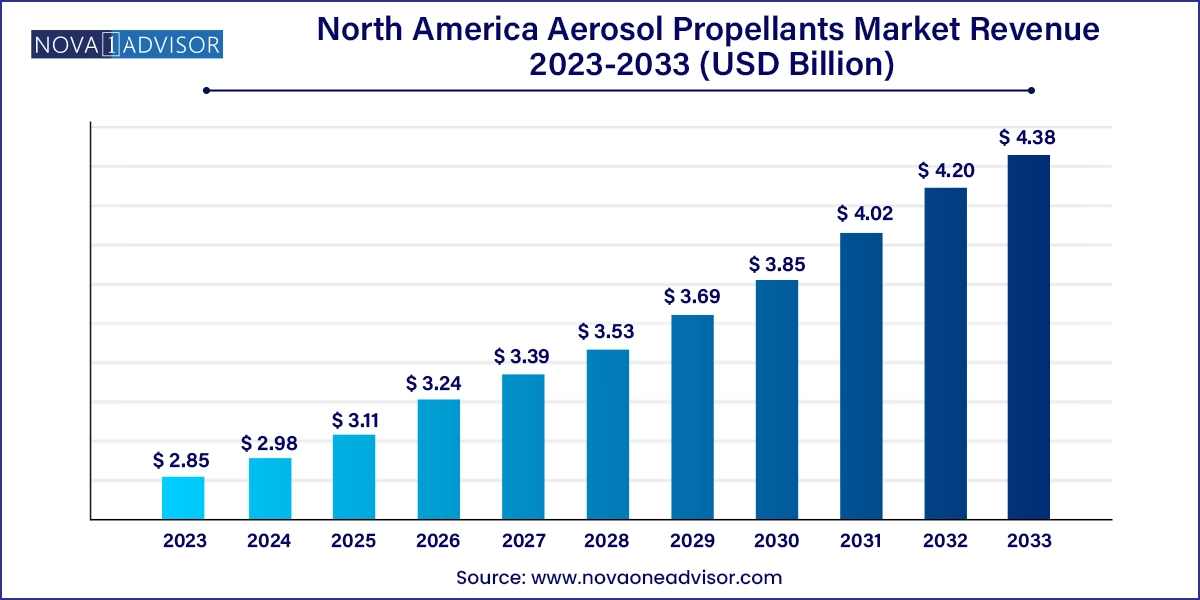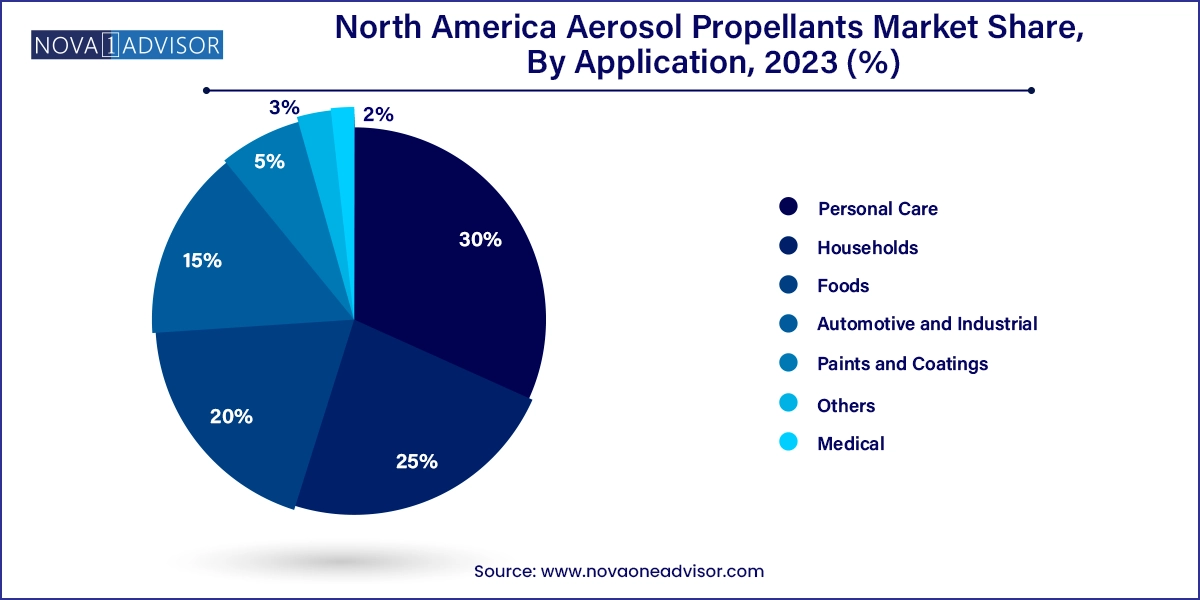The North America aerosol propellants market size was exhibited at USD 2.85 billion in 2023 and is projected to hit around USD 4.38 billion by 2033, growing at a CAGR of 4.4% during the forecast period 2024 to 2033.

| Report Coverage | Details |
| Market Size in 2024 | USD 2.98 Billion |
| Market Size by 2033 | USD 4.38 Billion |
| Growth Rate From 2024 to 2033 | CAGR of 4.4% |
| Base Year | 2023 |
| Forecast Period | 2024-2033 |
| Segments Covered | Product, Application, Country |
| Market Analysis (Terms Used) | Value (US$ Million/Billion) or (Volume/Units) |
| Country scope | U.S., Canada, Mexico |
| Key Companies Profiled | Royal Dutch Shell PLC; Honeywell International Inc.; Arkema Group; The Chemours Company; Nouryon; Aeropres Corporation; BOC Ltd.; AkzoNobel NV; DuPont de Nemours, Inc.; Lapolla Industries Inc |
This growth is attributed to several key driving factors including the significant expansion of the cosmetic industry, leading to an increased preference for aerosol-based products. These propellants find application in antiperspirants, shaving creams, hair mousses, and air fresheners. Secondly, the trend of urbanization, especially in developing economies, has spurred demand for aerosol-based household formulations such as insect repellents, disinfectants, and air fresheners.
Aerosol paints are widely used for refurbishing vehicles, touching up dents, and enhancing aesthetics. Furthermore, innovations like environment-friendly propellants have gained traction. These cans minimize volatile organic compounds (VOCs) and find applications in health and hygiene products. Rising consumer spending capacity and the continual launch of novel gender-specific personal care items further bolster the market’s prospects.
Regulations play a crucial role in shaping the market. For instance, Section 610 (d) of the Clean Air Act resulted in the prohibition of HCFC-141b in aerosol solvents. Additionally, there are increasing government and environmental regulations concerning ozone layer depletion, attributed to compounds like CFC, HCFC, and HFC. These stringent measures are expected to restrain the market’s growth in the near future. Furthermore, the phasing out of chlorofluorocarbons (CFCs) as propellants due to regulatory requirements regarding volatile organic compounds (VOC) emissions and ozone depletion potential (ODP) has significantly affected the industry in Europe, North America, and Asia-Pacific.
Hydrocarbons dominated the market with a revenue share of 81.5% in 2023. This dominance can be attributed to their widespread use in various applications due to their cost-effectiveness and ease of availability. Hydrocarbons, such as propane, butane, and isobutane, are commonly used as propellants in aerosol products. They are preferred for their low cost, high stability, and good performance characteristics. However, environmental concerns related to the use of hydrocarbons may impact their market share in the future.
On the other hand, dimethyl ether (DME) and methyl ethyl ether are projected to witness the fastest growth in terms of revenue, with a CAGR of 5.8% from 2024 to 2033. The growth of these segments can be attributed to their superior properties such as low toxicity, non-flammability, and high stability. These ethers are increasingly being used as alternatives to traditional hydrocarbon propellants in various applications, including personal care products, paints, and medical aerosols. Their rapid growth indicates a shift in the market towards more environmentally friendly and sustainable propellant options.
The personal care application dominated the market with a revenue share of 30.0% in 2023. This segment encompasses a wide range of products, including deodorants, hair sprays, shaving creams, and antiperspirants. The high market share is indicative of the growing consumer demand for personal hygiene and grooming products. The trend toward personal care products that offer conveniences, such as aerosol-based cosmetics and pharmaceuticals, has been a major growth driver.

The medical segment is projected to experience the fastest growth, with a CAGR of 6.9% from 2024 to 2033. This rapid growth can be attributed to the increasing use of aerosol propellants in pharmaceutical applications, including inhalers and topical medications. The convenience and precision in dosage that aerosol delivery systems provide make them indispensable in medical treatments. Moreover, the ongoing research and development in the field of aerosol medicine are likely to introduce innovative products that could further drive the demand for product in this segment. The aging population and the rising prevalence of respiratory diseases are additional factors contributing to the growth.
U.S. Aerosol Propellants Market Trends
The U.S. dominated the market with a revenue share of 79.3% in 2023. The country holds a pivotal position in the North America aerosol propellants market, driven by robust demand in personal care and household applications. The market is propelled by technological advancements and the presence of major industry players who are focusing on eco-friendly and low-VOC products. The U.S. market is also influenced by stringent regulations on aerosol emissions, which has led to innovation in product development to meet environmental standards.
Canada Aerosol Propellants Market Trends
Canada’s aerosol propellants market is a significant contributor to the North American region. The market benefits from the country’s advanced healthcare and personal care industries. Canadian consumers’ growing awareness of eco-friendly products is shaping the market. The demand for aerosol propellants in food applications is also on the rise, reflecting global trends towards convenience in food packaging.
This report forecasts revenue growth at country levels and provides an analysis of the latest industry trends in each of the sub-segments from 2021 to 2033. For this study, Nova one advisor, Inc. has segmented the North America aerosol propellants market
Product
Application
Country
Chapter 1. Methodology and Scope
1.1. Market Segmentation & Scope
1.2. Market Definition
1.3. Information Procurement
1.3.1. Information Analysis
1.3.2. Market Formulation & Data Visualization
1.3.3. Data Validation & Publishing
1.4. Research Scope and Assumptions
1.4.1. List of Data Sources
Chapter 2. Executive Summary
2.1. Market Snapshot
2.2. Segment Outlook
2.3. Competitive Landscape Snapshot
Chapter 3. North America Aerosol Propellants Market Variables, Trends & Scope
3.1. Market Lineage Outlook
3.1.1. Global Aerosol Propellants Market Outlook
3.2. Industry Value Chain Analysis
3.2.1. Raw Material Trends
3.2.2. Sales Channel Analysis
3.3. Manufacturing/Technology Overview
3.4. Regulatory Framework
3.5. Market Dynamics
3.5.1. Market Driver Analysis
3.5.2. Market Restraint Analysis
3.5.3. Industry Challenges
3.5.4. Industry Opportunities
3.6. PORTER’s Five Forces Analysis
3.6.1. Supplier Power
3.6.2. Buyer Power
3.6.3. Substitution Threat
3.6.4. Threat from New Entrant
3.6.5. Competitive Rivalry
3.7. PESTEL Analysis
3.7.1. Political Landscape
3.7.2. Economic Landscape
3.7.3. Social Landscape
3.7.4. Technological Landscape
3.7.5. Environmental Landscape
3.7.6. Legal Landscape
Chapter 4. North America Aerosol Propellants Market: Product Outlook Estimates & Forecasts
4.1. North America Aerosol Propellants Market Estimates & Forecast, By Product, 2021 to 2033
4.2. Hydrocarbons
4.2.1. Market estimates and forecasts, 2021 - 2033 (Kilotons) (USD Million)
4.3. DME
4.3.1. Market estimates and forecasts, 2021 - 2033 (Kilotons) (USD Million)
4.4. Nitrous Oxide & Carbon Dioxide
4.4.1. Market estimates and forecasts, 2021 - 2033 (Kilotons) (USD Million)
4.5. Others
4.5.1. Market estimates and forecasts, 2021 - 2033 (Kilotons) (USD Million)
Chapter 5. North America Aerosol Propellants Market: Application Outlook Estimates & Forecasts
5.1. North America Aerosol Propellants Market Estimates & Forecast, By Application, 2021 to 2033
5.2. Personal Care
5.2.1. Market estimates and forecasts, 2021 - 2033 (Kilotons) (USD Million)
5.3. Household
5.3.1. Market estimates and forecasts, 2021 - 2033 (Kilotons) (USD Million)
5.4. Automotive & Industrial
5.4.1. Market estimates and forecasts, 2021 - 2033 (Kilotons) (USD Million)
5.5. Food
5.5.1. Market estimates and forecasts, 2021 - 2033 (Kilotons) (USD Million)
5.6. Paints & Coatings
5.6.1. Market estimates and forecasts, 2021 - 2033 (Kilotons) (USD Million)
5.7. Automotive & Industrial Medical
5.7.1. Market estimates and forecasts, 2021 - 2033 (Kilotons) (USD Million)
5.8. Other Applications
5.8.1. Market estimates and forecasts, 2021 - 2033 (Kilotons) (USD Million)
Chapter 6. North America Aerosol Propellants Market: Region Outlook Estimates & Forecasts
6.1. Regional Market Snapshot
6.2. U.S.
6.2.1. Market estimates and forecasts, 2021 - 2033 (Kilotons) (USD Million)
6.2.2. Market estimates and forecasts, by product, 2021 - 2033 (Kilotons) (USD Million)
6.2.3. Market estimates and forecasts, by application, 2018- 2030 (Kilotons) (USD Million)
6.3. Canada
6.3.1. Market estimates and forecasts, 2021 - 2033 (Tons) (USD Million)
6.3.2. Market estimates and forecasts, by product, 2021 - 2033 (Kilotons) (USD Million)
6.3.3. Market estimates and forecasts, by application, 2018- 2030 (Kilotons) (USD Million)
6.4. Mexico
6.4.1. Market estimates and forecasts, 2021 - 2033 (Tons) (USD Million)
6.4.2. Market estimates and forecasts, by product, 2021 - 2033 (Kilotons) (USD Million)
6.4.3. Market estimates and forecasts, by application, 2021 - 2033 (Kilotons) (USD Million)
Chapter 7. North America Aerosol Propellants Market - Competitive Landscape
7.1. Recent Developments & Impact Analysis, By Key Market Participants
7.2. Company Categorization
7.3. Company Market Share/Position Analysis, 2023
7.4. Company Heat Map Analysis
7.5. Kraljic Matrix
7.6. Strategy Mapping
7.7. Company Profiles/Listings
7.7.1. Royal Dutch Shell PLC
7.7.1.1. Participant’s overview
7.7.1.2. Financial performance
7.7.1.3. Product benchmarking
7.7.1.4. Recent developments
7.7.2. Honeywell International Inc.
7.7.2.1. Participant’s overview
7.7.2.2. Financial performance
7.7.2.3. Product benchmarking
7.7.2.4. Recent developments
7.7.3. Arkema Group
7.7.3.1. Participant’s overview
7.7.3.2. Financial performance
7.7.3.3. Product benchmarking
7.7.3.4. Recent developments
7.7.4. The Chemours Company
7.7.4.1. Participant’s overview
7.7.4.2. Financial performance
7.7.4.3. Product benchmarking
7.7.4.4. Recent developments
7.7.5. Nouryon
7.7.5.1. Participant’s overview
7.7.5.2. Financial performance
7.7.5.3. Product benchmarking
7.7.5.4. Recent developments
7.7.6. Aeropres Corporation
7.7.6.1. Participant’s overview
7.7.6.2. Financial performance
7.7.6.3. Product benchmarking
7.7.6.4. Recent developments
7.7.7. BOC Ltd.
7.7.7.1. Participant’s overview
7.7.7.2. Financial performance
7.7.7.3. Product benchmarking
7.7.7.4. Recent developments
7.7.8. AkzoNobel NV
7.7.8.1. Participant’s overview
7.7.8.2. Financial performance
7.7.8.3. Product benchmarking
7.7.8.4. Recent developments
7.7.9. DuPont de Nemours, Inc.
7.7.9.1. Participant’s overview
7.7.9.2. Financial performance
7.7.9.3. Product benchmarking
7.7.9.4. Recent developments
7.7.10. Lapolla Industries Inc
7.7.10.1. Participant’s overview
7.7.10.2. Financial performance
7.7.10.3. Product benchmarking
7.7.10.4. Recent developments